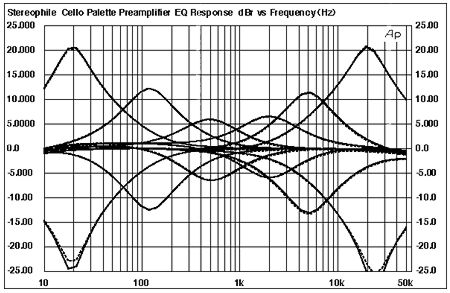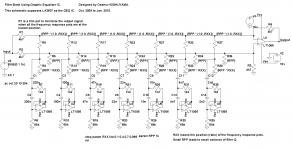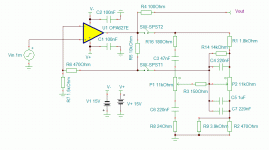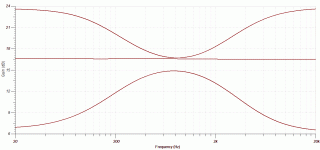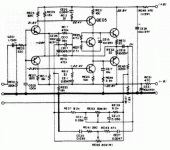Like putting milk and sugar in your coffee.
Next time by, your Turkish coffee comes with no sugar
dave
Hi,
Sorry, I completely missed this thread...
Okay, let us first collect the arguments for and against tone controls:
In my personal view the benefits argue strongly for the inclusion of tone controls in a true HiFi System and I would contend that the negatives that are often listed, while real, can be addressed.
The "quintessential modern" tone control, found in almost all references looks like this:
The Tone Stack is a classic active Baxandall. which has the benefit that it can use linear law and hence easily obtained potentiometers, that it is flat in the center position and is calculated without much work. These benefits have made it essentially the completely ubiquitous solution for tone controls in consumer equipment...
The issues that this circuit has low and variable input impedance and inverts polarity is addressed by adding an inverting unity gain buffer in the example. In other cases the polarity inversion is ignored and only the tone control circuit is looped in following a low impedance stage. This can be seen in the schematic of the Adcom GFP-565:
The practice of ignoring the polarity inversion of this circuit may raise some eyebrows, the tradeoff is the need to add another stage or to live with the polarity inversion if the tone controls are used. Neither option seems ideal, but life is full compromises and TANSTAAFL...
Such a circuit as in in the example may be inserted either between source selection and volume control (which may lead to issues with overload margins, but minimises additional noise or after an active preamp stage as seen in above's Adcom example with or without buffer.
Noise needs to be watched, in the above example the two 100K resistors in the buffer stage will produce around -108dBV Johnson noise and if the Op-Amp has significant current noise on the input (e.g. is not a Fet Input Type) the noise may be much higher, on the other hand if we lower the resistors to 10K (giving -118dBV noise) we increase the loading onto the circuit driving the buffer and conceivably reduce the preceding circuits linearity.
The same also goes for the Tone Control circuit itself, if we have too high impedances in the tone control noise will increase yet if we lower the impedances too much, linearity will be compromised.
On a positive note, this kind of circuit can also be extended with additional controls and IN PRINCIPLE at least could be extended enough to offer similar adjustments as the (in)Famous Cello Palette.
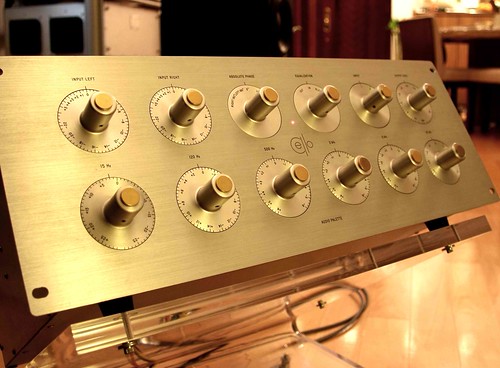
The Cello Palette is IMNSHO among the better solutions to problem or a program "re-equaliser" for non-sound engineers (compared to classic graphic EQ's or Parametric EQ's which likely get nods of approval from fellow sound engineers).

Even a numbers of Studio's prefer using the Palette over other equalisers, I suspect mainly because of the very intuitive way it is operated. Above it can be seen in the setup used by Wilma Cozart Fine for re-mastring the Mercury "Living Presence" Tapes and Films for release on CD and SACD.
The linked article at Headwize contains all the math needed and for example Tina-Ti, the free simulator from Texas Instruments may be used to simulate such a system, it already contains a tone control as shown above to get started. Stereophile measured the Palette Preamplifier and hence the curves are available to be implemented in a "DIY Palette":
The exercise to produce the schematic for an "Active Baxandall" Palette is left to the Reader, it'd be trivial enough.
Finally, while I am sure there are many here would probably insist that even using an NE5532 per channel the above example circuit will be totally transparent, others may opine that any two added op-amp's and the extra switching will compromise the performance of a pre-amplifier.
Personally I would suggest that in many cases where a tone control is desired and care is taken in circuit design as well as the selection of parts, I see no reason for the Baxandall control to be a major problem, though one would of course want to use no lesser Op-Amp's than for the actual line stage and no lesser controls for Tone than for Volume, etc...
If I where put on the spot how to arrange an effective, but low cost solution using the above example, I would likely use Fet Input Op-Amp's, as I find many excellent reasons to rely on such in audio circuits that use potentiometers. I would likely limit the adjustment range to +/-10dB and place the tone control between input selector and volume control, fully bypassable.
In this case using an OPA2604 and 24V rails will give us easily > 14V RMS without clipping so we can handle even sources with 4V maximum output at maximum boost for the tone control without risk of clipping and we minimise the impact of extra noise.
With my preferred 10K volume control and an equally 10K input impedance for the buffer and 10K controls for the tone control the system still will offer around -117dB dynamic range for a 2V input signal, so not quite up to 20 Bit standards, acceptable. As the OPA2604 is designed for full output into 600 Ohm at 24V rails even our low impedance circuit (to lower noise) is not a big problem in terms of distortion.
Still, a minority, among which I count myself will not be pleased with the "0815 Bog Standard" solution and it's limitations and will seek ones that require less circuitry, have less issues with noise and can be bypassed completely transparently. To those many a 1970's and 1980's Japanese Amplifier or pre-amplifier schematic may provide many an excellent idea. These we will talk about next.
Ciao T
Further to this discussion on EQ & Tone Control:
.....
Thorsten, the stage is your ....
Sorry, I completely missed this thread...
Okay, let us first collect the arguments for and against tone controls:
- + Can be used to correct for incorrect tonal balance in mastering
- + Can be used to correct for incorrect LP EQ
- + Can be used to correct for lower listening levels which induce percieved LF Loss
- -Usually require much extra circuitry to implement
- -Usually have only two bands, which is insuffcient for real "re-mastering"
- -Usually have so much adjustment range that small adjustments are not possible
- -Usually cannot be bypassed transparentlyEQ
- -When inserted (but flat) can lead to a percieved loss of fidelity
In my personal view the benefits argue strongly for the inclusion of tone controls in a true HiFi System and I would contend that the negatives that are often listed, while real, can be addressed.
The "quintessential modern" tone control, found in almost all references looks like this:
Headwize said:An externally hosted image should be here but it was not working when we last tested it.
The Tone Stack is a classic active Baxandall. which has the benefit that it can use linear law and hence easily obtained potentiometers, that it is flat in the center position and is calculated without much work. These benefits have made it essentially the completely ubiquitous solution for tone controls in consumer equipment...
The issues that this circuit has low and variable input impedance and inverts polarity is addressed by adding an inverting unity gain buffer in the example. In other cases the polarity inversion is ignored and only the tone control circuit is looped in following a low impedance stage. This can be seen in the schematic of the Adcom GFP-565:
Adcom said:An externally hosted image should be here but it was not working when we last tested it.
The practice of ignoring the polarity inversion of this circuit may raise some eyebrows, the tradeoff is the need to add another stage or to live with the polarity inversion if the tone controls are used. Neither option seems ideal, but life is full compromises and TANSTAAFL...
Such a circuit as in in the example may be inserted either between source selection and volume control (which may lead to issues with overload margins, but minimises additional noise or after an active preamp stage as seen in above's Adcom example with or without buffer.
Noise needs to be watched, in the above example the two 100K resistors in the buffer stage will produce around -108dBV Johnson noise and if the Op-Amp has significant current noise on the input (e.g. is not a Fet Input Type) the noise may be much higher, on the other hand if we lower the resistors to 10K (giving -118dBV noise) we increase the loading onto the circuit driving the buffer and conceivably reduce the preceding circuits linearity.
The same also goes for the Tone Control circuit itself, if we have too high impedances in the tone control noise will increase yet if we lower the impedances too much, linearity will be compromised.
On a positive note, this kind of circuit can also be extended with additional controls and IN PRINCIPLE at least could be extended enough to offer similar adjustments as the (in)Famous Cello Palette.

The Cello Palette is IMNSHO among the better solutions to problem or a program "re-equaliser" for non-sound engineers (compared to classic graphic EQ's or Parametric EQ's which likely get nods of approval from fellow sound engineers).

Even a numbers of Studio's prefer using the Palette over other equalisers, I suspect mainly because of the very intuitive way it is operated. Above it can be seen in the setup used by Wilma Cozart Fine for re-mastring the Mercury "Living Presence" Tapes and Films for release on CD and SACD.
Headwize said:An externally hosted image should be here but it was not working when we last tested it.
The linked article at Headwize contains all the math needed and for example Tina-Ti, the free simulator from Texas Instruments may be used to simulate such a system, it already contains a tone control as shown above to get started. Stereophile measured the Palette Preamplifier and hence the curves are available to be implemented in a "DIY Palette":
Stereophile said:
The exercise to produce the schematic for an "Active Baxandall" Palette is left to the Reader, it'd be trivial enough.
Finally, while I am sure there are many here would probably insist that even using an NE5532 per channel the above example circuit will be totally transparent, others may opine that any two added op-amp's and the extra switching will compromise the performance of a pre-amplifier.
Personally I would suggest that in many cases where a tone control is desired and care is taken in circuit design as well as the selection of parts, I see no reason for the Baxandall control to be a major problem, though one would of course want to use no lesser Op-Amp's than for the actual line stage and no lesser controls for Tone than for Volume, etc...
If I where put on the spot how to arrange an effective, but low cost solution using the above example, I would likely use Fet Input Op-Amp's, as I find many excellent reasons to rely on such in audio circuits that use potentiometers. I would likely limit the adjustment range to +/-10dB and place the tone control between input selector and volume control, fully bypassable.
In this case using an OPA2604 and 24V rails will give us easily > 14V RMS without clipping so we can handle even sources with 4V maximum output at maximum boost for the tone control without risk of clipping and we minimise the impact of extra noise.
With my preferred 10K volume control and an equally 10K input impedance for the buffer and 10K controls for the tone control the system still will offer around -117dB dynamic range for a 2V input signal, so not quite up to 20 Bit standards, acceptable. As the OPA2604 is designed for full output into 600 Ohm at 24V rails even our low impedance circuit (to lower noise) is not a big problem in terms of distortion.
Still, a minority, among which I count myself will not be pleased with the "0815 Bog Standard" solution and it's limitations and will seek ones that require less circuitry, have less issues with noise and can be bypassed completely transparently. To those many a 1970's and 1980's Japanese Amplifier or pre-amplifier schematic may provide many an excellent idea. These we will talk about next.
Ciao T
Hi,
This is basically a classic graphic EQ circuit. Instead of op-amp gyrators they can also be made with single transistors or J-Fets (or even tubes) and real inductors are also an option.
The Main Op-Amp can be discrete. While non-inverting the input impedance is also quite low, so many of the issues remain and it is STILL an addition.
It is even possible to use this kind of circuit with what would look nominally like a Concertina Tube Phase Splitter (unity gain) to make a completely Tube based, minimalist EQ.
I'm undecided if this is better than a multi-way parallel Baxandall, at 6 Ways Palette style at least, which also comes in "tube". Maybe.
There comes a point where it is clearly one of the ways to go though...
Ciao T
I was wondering what took you so long.
How would you rate this one ?
It is easy enough to change the buffer to discrete.
This is basically a classic graphic EQ circuit. Instead of op-amp gyrators they can also be made with single transistors or J-Fets (or even tubes) and real inductors are also an option.
The Main Op-Amp can be discrete. While non-inverting the input impedance is also quite low, so many of the issues remain and it is STILL an addition.
It is even possible to use this kind of circuit with what would look nominally like a Concertina Tube Phase Splitter (unity gain) to make a completely Tube based, minimalist EQ.
I'm undecided if this is better than a multi-way parallel Baxandall, at 6 Ways Palette style at least, which also comes in "tube". Maybe.
There comes a point where it is clearly one of the ways to go though...
Ciao T
> While non-inverting the input impedance is also quite low, so many of the issues remain and it is STILL an addition.
The Baxandall has a buffer stage upfront.
Doing the same will solve the input impedance issues.
The Hoshuyama needs a lot more active devices, which is arguably a disadvantage.
patrick
The Baxandall has a buffer stage upfront.
Doing the same will solve the input impedance issues.
The Hoshuyama needs a lot more active devices, which is arguably a disadvantage.
patrick
Doug Selfs design from a few years back seemed genuinely useful... and I built a test version of it. I would certainly consider incorporating something like this into a new amp build.
http://www.diyaudio.com/forums/soli...-built-listened-d-selfs-precision-preamp.html
http://www.diyaudio.com/forums/soli...-built-listened-d-selfs-precision-preamp.html
---flat is a term used when we need to reproduce the recording as was
--- when a system cannot reproduce this "flat" properly without tone controls then the problem lays in the chain of the system and not in the recording.
---fact any tone control even coming form the moon or jupiter will add something in a system ( call it noise ,hiss,colour what ever ) so choise is yours any way
----implementation of a tone control as seen from a schematic ( as for most audio circuits ) will be pcb/supply/bypass/decoupling/earth distribution /impentance matching depenting ... so to achive a lot of 000000 when it comes to real life construction is not an easy target...
---Obviously ( you simulator freaks ) may the circuit simulates for 0.000013 thd but will this ever reproduced from your pcb/supply/cable rooting/ and so on ? i think not ...
----------------------
skiping the terminolgy and the above facts, obviously people get horny from a nice kicky bass and a crisp treble that can be added from a good tone control ...if is this correct or not its up to you to decide ...
kind flat regards sakis
--- when a system cannot reproduce this "flat" properly without tone controls then the problem lays in the chain of the system and not in the recording.
---fact any tone control even coming form the moon or jupiter will add something in a system ( call it noise ,hiss,colour what ever ) so choise is yours any way
----implementation of a tone control as seen from a schematic ( as for most audio circuits ) will be pcb/supply/bypass/decoupling/earth distribution /impentance matching depenting ... so to achive a lot of 000000 when it comes to real life construction is not an easy target...
---Obviously ( you simulator freaks ) may the circuit simulates for 0.000013 thd but will this ever reproduced from your pcb/supply/cable rooting/ and so on ? i think not ...
----------------------
skiping the terminolgy and the above facts, obviously people get horny from a nice kicky bass and a crisp treble that can be added from a good tone control ...if is this correct or not its up to you to decide ...
kind flat regards sakis
Last edited:
one more thing ..... in the age of 16 i was looking for preamps with available tones to +-20db
in the age of 45 i ve learned how to built amplifiers 10 years now i dont use tone controls to my listening ... ( never needed to )
also ...when you repair 200-300 comercial amplifiers per year you get the chance to evaluate almost any available tone control circuit and most of available implemantations ...
Take my word for it almost none of them when it comes to flat this is a really flat ....even tone control switches are decorative items ....and only very few had the best standards ..one YAMAHA ....one ACCUPHASE ...very very few
Other than that even in the age of 45 ( i think of my shelf quite young !! ) the most sonic producing tone control circuits i liked was the old style japanese passive tone controls bassed on the feedback chain of comercial amplifiers but ...as we all know this wasnt correct and produced stabilty issues ...
still the colours was wonderfull ( or marvelous as my wife says !! )
in the age of 45 i ve learned how to built amplifiers 10 years now i dont use tone controls to my listening ... ( never needed to )
also ...when you repair 200-300 comercial amplifiers per year you get the chance to evaluate almost any available tone control circuit and most of available implemantations ...
Take my word for it almost none of them when it comes to flat this is a really flat ....even tone control switches are decorative items ....and only very few had the best standards ..one YAMAHA ....one ACCUPHASE ...very very few
Other than that even in the age of 45 ( i think of my shelf quite young !! ) the most sonic producing tone control circuits i liked was the old style japanese passive tone controls bassed on the feedback chain of comercial amplifiers but ...as we all know this wasnt correct and produced stabilty issues ...
still the colours was wonderfull ( or marvelous as my wife says !! )
one more thing ..... in the age of 16 i was looking for preamps with available tones to +-20db
in the age of 45 i ve learned how to built amplifiers 10 years now i dont use tone controls to my listening ... ( never needed to )
also ...when you repair 200-300 comercial amplifiers per year you get the chance to evaluate almost any available tone control circuit and most of available implemantations ...
Take my word for it almost none of them when it comes to flat this is a really flat ....even tone control switches are decorative items ....and only very few had the best standards ..one YAMAHA ....one ACCUPHASE ...very very few
Other than that even in the age of 45 ( i think of my shelf quite young !! )
the most sonic producing tone control circuits i liked was the old style japanese passive tone controls bassed on the feedback chain of comercial amplifiers but ...as we all know this wasnt correct and produced stabilty issues ...
still the colours was wonderfull ( or marvelous as my wife says !! )
I have plenty of old mono jazz LP's that could do with a lift. I haven't had a pre with tone controls for the last 20 years, but recently contemplated incorporating a pultec equalizer into my pre ( valve). Surely it could be switched in only when required.
naim cd players feature a function operated by the remote control to either use a classic RCA output plug or the naim style DIN plug ...
said to my shelf that the quality of this machine is equal or lower to the OP amps or circuits that exist in the output operating these functions ..
obviously High end equipment should not have thngs like that and especially to only serve interconnectivity only ...
got my point ?
said to my shelf that the quality of this machine is equal or lower to the OP amps or circuits that exist in the output operating these functions ..
obviously High end equipment should not have thngs like that and especially to only serve interconnectivity only ...
got my point ?
Hi,
It is based on a version of state variable filters for mixing desks.
I am not very convinced of it's merits, compared to other options. If you use fixed frequencies it does nothing that a Baxandall type does not do with fewer components.
And if you actually need variable turnover frequencies this can be applied to a Baxandall too (switched in steps) but you really would likely be better of with two more bands instead of varying the centre frequencies IMNSHO.
But to each his own.
Ciao T
Doug Selfs design from a few years back seemed genuinely useful...
It is based on a version of state variable filters for mixing desks.
I am not very convinced of it's merits, compared to other options. If you use fixed frequencies it does nothing that a Baxandall type does not do with fewer components.
And if you actually need variable turnover frequencies this can be applied to a Baxandall too (switched in steps) but you really would likely be better of with two more bands instead of varying the centre frequencies IMNSHO.
But to each his own.
Ciao T
Hi,
Sorry, but you never worked in music recording, right?
With way too many recordings the problem is the recording. Then I have the option to correct the tonal problems, or to not listen to this recording.
Another issue is playback level. At quieter than intended listening levels a recording will sound bass shy, due to the way the human hearing works.
The actual fact is that it is entirely possible to design a tone control that when bypassed has ABSOLUTELY ZERO impact on the sound and when in use other than intended operation adds extremely little, certainly not noise or distortion from extra circuitry, colourations are of course possible (no passive components are absolutely neutral), but these levels can be made as low as any normal active linestage at a comparable quality level.
Nothing worth doing is trivially easy, otherwise everyone would do it. But a tonecontrol is really not that hard, a RIAA preamp is much harder...
Actually, I mostly need the treble control to reduce treble recorded too hot (a common sin in modern recordings), the bass often too needs a cut, or in some cases listening very quietly a bit of a boost.
The quiet listening part is of course where the so-called "loudness control" comes in, however the common implementations in common HiFi systems have issues with correcting at levels that are meant to be played back without correction and correcting the wrong things.
Ciao T
---flat is a term used when we need to reproduce the recording as was
--- when a system cannot reproduce this "flat" properly without tone controls then the problem lays in the chain of the system and not in the recording.
Sorry, but you never worked in music recording, right?
With way too many recordings the problem is the recording. Then I have the option to correct the tonal problems, or to not listen to this recording.
Another issue is playback level. At quieter than intended listening levels a recording will sound bass shy, due to the way the human hearing works.
---fact any tone control even coming form the moon or jupiter will add something in a system ( call it noise ,hiss,colour what ever ) so choise is yours any way
The actual fact is that it is entirely possible to design a tone control that when bypassed has ABSOLUTELY ZERO impact on the sound and when in use other than intended operation adds extremely little, certainly not noise or distortion from extra circuitry, colourations are of course possible (no passive components are absolutely neutral), but these levels can be made as low as any normal active linestage at a comparable quality level.
----implementation of a tone control as seen from a schematic ( as for most audio circuits ) will be pcb/supply/bypass/decoupling/earth distribution /impentance matching depenting ... so to achive a lot of 000000 when it comes to real life construction is not an easy target...
Nothing worth doing is trivially easy, otherwise everyone would do it. But a tonecontrol is really not that hard, a RIAA preamp is much harder...
skiping the terminolgy and the above facts, obviously people get horny from a nice kicky bass and a crisp treble that can be added from a good tone control ...if is this correct or not its up to you to decide ...
Actually, I mostly need the treble control to reduce treble recorded too hot (a common sin in modern recordings), the bass often too needs a cut, or in some cases listening very quietly a bit of a boost.
The quiet listening part is of course where the so-called "loudness control" comes in, however the common implementations in common HiFi systems have issues with correcting at levels that are meant to be played back without correction and correcting the wrong things.
Ciao T
Hi,
Okay, here is one scheme that delivers the following:
It is in essence the combination of a standard line stage and a passive Baxandall/James tone stack in the feedback loop.
This used to be quite common and was found among others in the Marshall Leach preamplifier from 1979, certain GAS designs and various Hafler preamplifiers and it was widely used by the Japanese electronics industry.
I have attached both the schematic (from Tina Ti) and the frequency response for the pots centred as well at max boost/cut. This example is based on an extract out of a Luxman pre finetuned to suit my precise application and stock of parts...
It requires "C-Law" (aka anti-log) potentiometers if potentiometers are used. These are nowadays hard to get, I lucked into a few very nice quality ones (above Alps Blue) so this is what I will use. It also has a slightly asymmetric adjustment response, there is a dB or so more cut than boost.
This is a result of optimising the circuit for parts I have and for minimal gain changes and maximal gain flatness when switching the tone control set to flat and switched in and out.
The adjustment range is +6.5dB / -7.5dB @ 50Hz and +7dB / -7.5dB @ 10KHz, which is enough for some fine adjustment of tonal balance.
The gain circuit shown as OPA627 can be any sort of Op-Amp with enough open loop gain, John Curls JC-2 linestage could for example be used, or any nice discrete Op-Amp you have in mind for line stage duties, Fet Input should be seriously considered.
Ciao T
Still, a minority, among which I count myself will not be pleased with the "0815 Bog Standard" solution and it's limitations and will seek ones that require less circuitry, have less issues with noise and can be bypassed completely transparently. To those many a 1970's and 1980's Japanese Amplifier or pre-amplifier schematic may provide many an excellent idea. These we will talk about next.
Okay, here is one scheme that delivers the following:
- No effect on the audio circuit when defeated
- Minimal added circuitry
- Minimal effect of tone control circuitry on fidelity when engaged
It is in essence the combination of a standard line stage and a passive Baxandall/James tone stack in the feedback loop.
This used to be quite common and was found among others in the Marshall Leach preamplifier from 1979, certain GAS designs and various Hafler preamplifiers and it was widely used by the Japanese electronics industry.
I have attached both the schematic (from Tina Ti) and the frequency response for the pots centred as well at max boost/cut. This example is based on an extract out of a Luxman pre finetuned to suit my precise application and stock of parts...
It requires "C-Law" (aka anti-log) potentiometers if potentiometers are used. These are nowadays hard to get, I lucked into a few very nice quality ones (above Alps Blue) so this is what I will use. It also has a slightly asymmetric adjustment response, there is a dB or so more cut than boost.
This is a result of optimising the circuit for parts I have and for minimal gain changes and maximal gain flatness when switching the tone control set to flat and switched in and out.
The adjustment range is +6.5dB / -7.5dB @ 50Hz and +7dB / -7.5dB @ 10KHz, which is enough for some fine adjustment of tonal balance.
The gain circuit shown as OPA627 can be any sort of Op-Amp with enough open loop gain, John Curls JC-2 linestage could for example be used, or any nice discrete Op-Amp you have in mind for line stage duties, Fet Input should be seriously considered.
Ciao T
Attachments
Hi,
We come to something along these lines later. Just without buffers and additional gain.
The passive Baxandall can of course be used directly. It can operate into the volume control, source loading will worse and we loose loads of gain.
With some tube line stages that have ton's too much gain already and operate without looped feedback we can actually use the Baxandall/James Tone control to burn this up and replace the Tone control with a resistor divider for bypass.
But somehow this "first attenuation and then re-amplification" sits a little uneasy with me. If we took the network scaled suitably from the previous example, we will have 16dB static attenuation, that's a lot.
My first ever Amplifier (I build this when around 8) had such an arrangement, Transistor Buffer with gain, Baxandall/James tone, Volume Control (with loudness naturally) and one of the first ever chipamp's, in stereo of course...
I have not used this style since...
Ciao T
How about a purely passive Baxandall sandwiched between 2 buffers, with or without gain ?
We come to something along these lines later. Just without buffers and additional gain.
The passive Baxandall can of course be used directly. It can operate into the volume control, source loading will worse and we loose loads of gain.
With some tube line stages that have ton's too much gain already and operate without looped feedback we can actually use the Baxandall/James Tone control to burn this up and replace the Tone control with a resistor divider for bypass.
But somehow this "first attenuation and then re-amplification" sits a little uneasy with me. If we took the network scaled suitably from the previous example, we will have 16dB static attenuation, that's a lot.
My first ever Amplifier (I build this when around 8) had such an arrangement, Transistor Buffer with gain, Baxandall/James tone, Volume Control (with loudness naturally) and one of the first ever chipamp's, in stereo of course...
I have not used this style since...
Ciao T
High End Tone Control???
I have had hard times choosing a high end preamp. And now a high end tone control? But how about a high end switch? This will be useful for defeating tone controls for example.
Ime, the tone control is not really a problem. The problem is with the preamp itself. I mean, adding a preamp will introduce problem soundwise, but adding a tone control properly to a preamp adds almost no additional problem. So may be a TC is indeed a mandatory addition to preamps, but imo depends on the "nature" of the preamp circuit itself.
Instead of incorporating the TC into the preamp circuit, I prefer a dedicated preceding TC circuit that can be bypassed with a (supposedly high end) switch.
I don't think opamp (chip) based can be high end, so I don't believe the Baxandall examples posted above will work. I will prefer a dedicated standard discrete circuit where the TC is handled in the feedback path. The locations of the poles are not critical as I need such circuit only to fix issues with low frequency boost.
A good switch will be installed on PCB with mechanical "cable wire" going to the front panel knob.
Along with a Baxandall , a traditionnal loudness should also be mandatory in any high end design...
I have had hard times choosing a high end preamp. And now a high end tone control? But how about a high end switch? This will be useful for defeating tone controls for example.
Ime, the tone control is not really a problem. The problem is with the preamp itself. I mean, adding a preamp will introduce problem soundwise, but adding a tone control properly to a preamp adds almost no additional problem. So may be a TC is indeed a mandatory addition to preamps, but imo depends on the "nature" of the preamp circuit itself.
Instead of incorporating the TC into the preamp circuit, I prefer a dedicated preceding TC circuit that can be bypassed with a (supposedly high end) switch.
I don't think opamp (chip) based can be high end, so I don't believe the Baxandall examples posted above will work. I will prefer a dedicated standard discrete circuit where the TC is handled in the feedback path. The locations of the poles are not critical as I need such circuit only to fix issues with low frequency boost.
A good switch will be installed on PCB with mechanical "cable wire" going to the front panel knob.
Attachments
Last edited:
You can look at the F-M or R-D equal loudness profiles and provide a simple analogue passive loudness compensation network around a standard (non center-tapped) pot in each channel to do something "close enough". With a little (actually big) help from a scientist on another forum, I did it. It is absolutely fantastic and doesn't even need a switch.
There is no commercial motivation behind the following link where I have had a bit of fun with it, but it's actually serious (the circuit is about half way down the long page): Audio Projects Extraordinary POQX Active Crossover
There is no commercial motivation behind the following link where I have had a bit of fun with it, but it's actually serious (the circuit is about half way down the long page): Audio Projects Extraordinary POQX Active Crossover
- Home
- Source & Line
- Analog Line Level
- High End Tone Control
